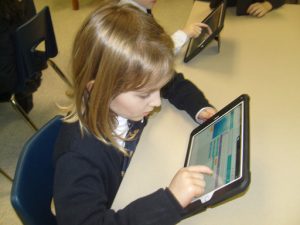At the risk of completely dating myself, I distinctly remember my first interaction with computers around Grade 3 as a group of us crowded around a singular Commodore PET computer in the corner of the classroom. Most the time spent with this PET consisted of playing a game where you controlled a virtual fish that could only eat smaller fish; attempting to eat larger fish taught you a hard lesson about ecology.

Fast forward to 2012 and a new job as an IT Help Desk Support Technician at Pickering College. Twenty brand new iPads landed in my office with a simple list of requested applications for me to install.

As a new employee I did what I was told; I installed the apps immediately and placed them in a cart for our Junior School students/teachers to use. Later, I took it upon myself to observe these iPads being used in the classroom. The students seemed quite engaged in the educational games that the teachers had chosen. A question kept nagging at me though – after all this time and all the advancements in technology, was this the only outcome? A pet device to “edu-tain” students?
Such a good question! From what I see going on with technology there is a lot of substitution level use of digital tools in classroom, which I think is a great first step towards meaningful use. My goal is always to help teachers see that these digital tools are more than digital worksheets and to help them move towards the redefinition end of the SAMR model. I think the work remains in helping teachers see what powerful tools digital devices can be by allowing them time to learn and providing support in implementing them!
I remember giving a presentation on the SAMR model to my teachers 2-3 years ago and I am always so impressed when teachers, even to this day, tell me how they used technology in ways that would be considered at the higher levels of the SAMR model.
I too thought about my first time using a computer for this assignment. It seems to me based on your observations and my experience back then, at the end of the day computers are a tool and regardless of the complexity or simplicity of the software, it is how they are used that will make the difference. I agree with Tracy, teachers have to be helped in developing ways of using technology to unlock the potential they possess.
It is always amazing to me when I look at the declining technological skill of our students despite the ever growing technology in front of them. Back when computers were first introduced there was a need for computer science skill involved. You needed to be able to type “Start X” for your startup screen and be able to navigate in DOS. With the introduction of Windows and other OS with the beautiful files and of course the ever popular “double click” we forgot what was behind that beautiful facade. The index finger epidemic increased exponentially with the holy grail of the iPad and the App being introduced into schools by the hundreds. One of the things I have been working on is to help teachers move away from “consumption” of technology to “creation”. There are some amazing examples of teachers doing magnificent things with technology (computers and iPads) don’t get me wrong. However there has been rampant misuse as well. Especially for our students with special needs who are given and iPad and an app to keep them busy at the back table. It is heartbreaking. Students that I see each day are lost when it comes to the inner workings of a computer, code, and creation. I feel we all need to ensure that we are using some kind of system of evaluation for what technology we are using in our classrooms and why. Does your district use any such system or are teacher able to request any app at any time?
Trish
We don’t have a formal process to evaluate technology integration right now, but I am currently doing research on it for my school. Fortunately, when teachers request to use a technology, it automatically gets filtered through me. I get the chance to sit down with the teacher(s) and discuss the learning outcomes and pedagogy behind the technology they have selected. In some cases, it generates very deep conversations that touch upon many of the thoughts that you conveyed in your message.
In my high school online classes, I have a project built into the courses so that the students are giving back — helping future students. For example, in a F2F class, students make posters and then at the end of the year they are taken down — not in my classes. Students make learning objects to help future students. Some of them can be seen on my youtube channel.
https://www.youtube.com/user/crozitis
How do your students give back?
Christopher
Hi Christopher,
At my school, we have the advantage of being both a K-12 school and a smaller school. We have built a couple cross-grade initiatives that last throughout the year. For instance, each Grade 2 has a Grade 11 learning buddy that works with them on various projects, including ones in Science, throughout the year. For our Computer Science class, we plan on expanding our relationship with a First Nations School by providing technology and computer repair services.
Cheers!
Gordon